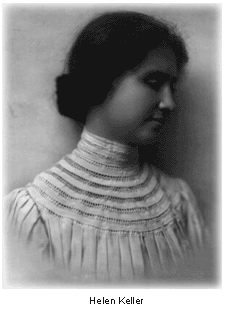When Anne Sullivan held her unruly young pupil's hand under flowing pump water and wrote the letter 'W' on her palm, a new world began to unfold and blossom for Helen Keller. Keller is famous for overcoming deafness and blindness to become an inspiration to disabled people, and advocates of the disabled, all over the world. With the aid of her teacher, then her secretary, Keller tirelessly campaigned for greater acceptance of handicapping conditions.
Helen Adams Keller was born on June 27, 1880, in Tuscumbia, Alabama. The daughter of Captain Arthur Henley Keller and Kate Adams Keller, she was born with full sight and hearing. In February 1882, when Helen was 19 months old, she became ill. The doctors of the time called it “brain fever;" however, modern-day physicians think it may have been scarlet fever or meningitis. Helen lost her vision and hearing, owing to her illness.
 Helen became a difficult child, prone to smashing dishes and lamps, and terrorizing the entire household with her screaming and temper tantrums. By the time Helen was six years old, her family was desperate for help. They were led to Alexander Graham Bell, who suggested that the family write to Michael Anagnos, director of the Perkins Institution and Massachusetts Asylum for the Blind, and request that he try to find a teacher for Helen. Anagnos recommended a former pupil of the institution, Anne Sullivan.
Following the dramatic breakthrough at the pump, Sullivan began to teach Helen finger spelling and eventually Braille. With persistence and hard work, Helen began to learn under Sullivan, and in 1894 she attended Wright-Humason School for the Deaf. She then enrolled in Cambridge School for Young Ladies in 1896, and in the fall of 1900 entered Radcliffe College, becoming the first deaf-blind person to enroll at an institution of higher learning. In 1904 she graduated with a bachelor's degree in art, making her the first deaf-blind person to earn a degree.
Keller and Sullivan conducted lecture tours, made a motion picture of Keller's life, and appeared on the vaudeville circuit for two years to help carry out her dedication to stimulate public interest in the problems of the physically disabled. Keller was the author of numerous books and spent much of her life raising money to help people who also were deaf and blind.
Following the death of her teacher and longtime friend in 1936, Keller recruited a new companion, Polly Thompson; she had been her secretary since 1914. Keller and Thompson spent years traveling the world, raising funds for the American Foundation for the Overseas Blind. They visited Japan, Australia, South America, Europe and Africa.
Keller retired from touring after suffering a series of strokes in 1961. She was awarded the Presidential Medal of Freedom, the nation’s highest civilian award, by President Lyndon B. Johnson in 1964. A year later, she was elected to the Women’s Hall of Fame at the New York World’s Fair.
Keller died peacefully in her sleep on June 1, 1968. Her remains were cremated in Bridgeport, Connecticut, and a funeral service was held at the National Cathedral in Washington, D.C., where the urn containing her ashes would later be placed next to those of Anne Sullivan and Polly Thompson. Today Helen Keller’s final resting place is a popular tourist attraction and the bronze plaque erected to commemorate her life has already been replaced twice.
Helen became a difficult child, prone to smashing dishes and lamps, and terrorizing the entire household with her screaming and temper tantrums. By the time Helen was six years old, her family was desperate for help. They were led to Alexander Graham Bell, who suggested that the family write to Michael Anagnos, director of the Perkins Institution and Massachusetts Asylum for the Blind, and request that he try to find a teacher for Helen. Anagnos recommended a former pupil of the institution, Anne Sullivan.
Following the dramatic breakthrough at the pump, Sullivan began to teach Helen finger spelling and eventually Braille. With persistence and hard work, Helen began to learn under Sullivan, and in 1894 she attended Wright-Humason School for the Deaf. She then enrolled in Cambridge School for Young Ladies in 1896, and in the fall of 1900 entered Radcliffe College, becoming the first deaf-blind person to enroll at an institution of higher learning. In 1904 she graduated with a bachelor's degree in art, making her the first deaf-blind person to earn a degree.
Keller and Sullivan conducted lecture tours, made a motion picture of Keller's life, and appeared on the vaudeville circuit for two years to help carry out her dedication to stimulate public interest in the problems of the physically disabled. Keller was the author of numerous books and spent much of her life raising money to help people who also were deaf and blind.
Following the death of her teacher and longtime friend in 1936, Keller recruited a new companion, Polly Thompson; she had been her secretary since 1914. Keller and Thompson spent years traveling the world, raising funds for the American Foundation for the Overseas Blind. They visited Japan, Australia, South America, Europe and Africa.
Keller retired from touring after suffering a series of strokes in 1961. She was awarded the Presidential Medal of Freedom, the nation’s highest civilian award, by President Lyndon B. Johnson in 1964. A year later, she was elected to the Women’s Hall of Fame at the New York World’s Fair.
Keller died peacefully in her sleep on June 1, 1968. Her remains were cremated in Bridgeport, Connecticut, and a funeral service was held at the National Cathedral in Washington, D.C., where the urn containing her ashes would later be placed next to those of Anne Sullivan and Polly Thompson. Today Helen Keller’s final resting place is a popular tourist attraction and the bronze plaque erected to commemorate her life has already been replaced twice.